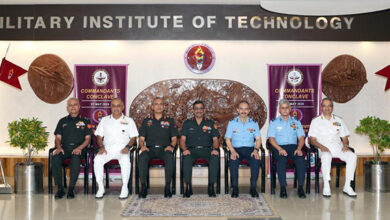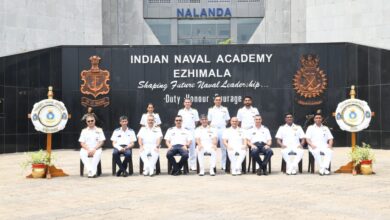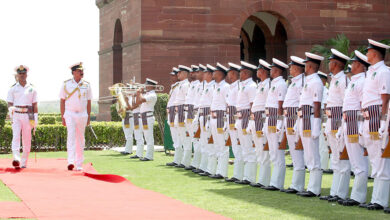India Marks Navy Day
New Delhi. India marked the Navy Day on December 4 with festive celebrations, inspiring parades, blood donation and medical care camps, homage to martyrs, and reaffirmation of pledges to strengthen the security of the country.

Chief of Naval Staff Admiral Sunil Lanba began the day by laying a wreath at the Amar Jawan Jyoti (or Eternal Flame) Martyrs Memorial here, and later held the Navy Chief’s annual reception which was attended by President Pranab Mukherjee, Prime Minister Narendra Modi, Defence Minister Manohar Parikkar, Chief of Air Staff Air Chief Marshal Arup Raha, Chief of Army Staff Gen Dalbir Singh, top officials from various ministries and the three Services, Diplomats and Journalists. Celebrations were held at all the naval bases.

In his pre-Navy Day annual news conference on December 2, Admiral Lanba assured the nation that the Indian Navy has adequate assets to tackle any challenges and that there have been periodic exercises with the Indian Air Force and Army to hone joint operational skills to overcome any threat.
There was due emphasis on coastal security, and with support from the National Committee for Strengthening Maritime and Coastal Security (NCSMCS), “we have brought multiple agencies of the government together,” he said adding: “This has enabled consolidation of our combined capabilities. Consequently, our operational readiness to secure our coastal and offshore regions has significantly improved.”
Naval Deployment
Admiral Lanba disclosd that the Indian Navy has 40 ships, four submarines and 12 aircraft deployed in waters near and far around the Indian peninsular and island territories, pointing out: “The operational philosophy, war-fighting capabilities and combat tactics of both our Fleets – Western and Eastern – have also been tested recently through a series of sea exercises” and that the Navy could assure the nation of required security “anytime, anywhere, every time.”
The Navy Chief was asked by newsmen about the possible threat posed by the Chinese navy’s presence in the Indian Ocean and its presence on the Pakistani ports, particularly the newly-built Gwadar. He reminded the nation that “there are thousands of valiant soldiers, sailors and air warriors who are standing guard on glaciers, mountains, deserts, plains, and patrolling our seas and our national air-space, for our nation’s security and ensure territorial integrity. The Indian armed forces can meet any challenge.
Notably, the tri-Service exercises also covered disaster relief operations. It may be recalled that in the 2004 tsunami, the Indian Navy had played a stellar role in providing timely and extensive assistance to neighbouring countries.

India celebrates the Navy Day annually on December 4 to mark the successful attack on Pakistan navy’s Karachi base in the 1971 Bangladesh Liberation War. India dominated the skies, the sea, and then the land to check Pakistan’s threats.
Neighbourly Goodwill Policy
The soft-spoken Chief also pointed out that the Navy was engaging other countries, particularly those in the Indian Ocean Rim, in positive spirit “in pursuance of our national foreign policy initiatives” of having friendly and good relations with all.
“We remain acutely aware of our duty to shape a favourable and positive maritime environment in the Indian Ocean Region,” he said adding that “the Indian Navy has accorded the highest priority to India’s neighbourhood in keeping with our Government’s ‘Neighbourhood First’ policy.”
Towards creating goodwill, “our ships have visited various ports and engaged with navies of countries in the Bay of Bengal, Southeast Asia, Sri Lanka and Maldives in 2016.”
And there have been diverse missions in far-flung seas also, including hydrographic surveys by INS Darshak around Tanzania and Mauritius, anti-piracy patrols by Frigates and Offshore Patrol Vessels in the Gulf of Aden, environment rehabilitation support to Fiji and participation in International Fleet Review at New Zealand by Sumitra. “Our core naval engagements have included exercises by Western Fleet ships with navies in the Gulf, East Africa and IOR island nations, and by Eastern Fleet ships in the Western Pacific including participation in the multi-national exercise RIMPAC at Hawaii.”
Highlighting the Navy’s goodwill efforts, Admiral Lanba praised the International Fleet Review held earlier this year at Vishakhapatnam, observing: The Indian Navy’s endeavour to promote maritime partnerships for common benefit of the global community was achieved with tremendous success during the International Fleet Review at Visakhapatnam in February this year. This event of national significance enabled us to bring diverse nations on a common platform to engage meaningfully for securing the maritime domain.
Capability Building
“The Navy has also advanced its capacity building and capability enhancement initiatives with navies and maritime security agencies this year. We have trained almost 1,000 personnel from over 40 navies in our training establishments, continued to deploy our ships and aircraft for EEZ patrols off Maldives, Seychelles and Mauritius, and provisioned ships, aircraft, helicopters and simulators, to friendly regional navies. Herein, I must highlight that our Advanced Light Helicopter deployed to Maldives with our crew, has undertaken multiple missions, including medical evacuations and Search and Rescue in Maldives.”
Admiral Lanba had taken over the command of the Indian Navy recently this year, succeeding Admiral Robin Dhowan. This was his first press conference, an event well organised and used also to inaugurate the Indian Navy’s new interactive website.
Admiral Lanba said that the Navy was continuously upgrading its assets, and recently it had conducted several exercises with the Indian Air Force and Army towards building professional excellence.

About the current and future naval programmes, there was emphasis on indigenous shipbuilding, and special attention was being paid to submarines. The next year, 2017, will be marked by the Navy as the Year of the Submarine.
The Navy Chief declined to give details of any nuclear assets or future programme.
The reception was also used as an occasion to highlight the Navy’s efforts towards innovations and ‘Make in India’ indigenisation of sub-systems of Naval equipment and weapons. Notably, the hull of most of the naval ships is already made in India.





